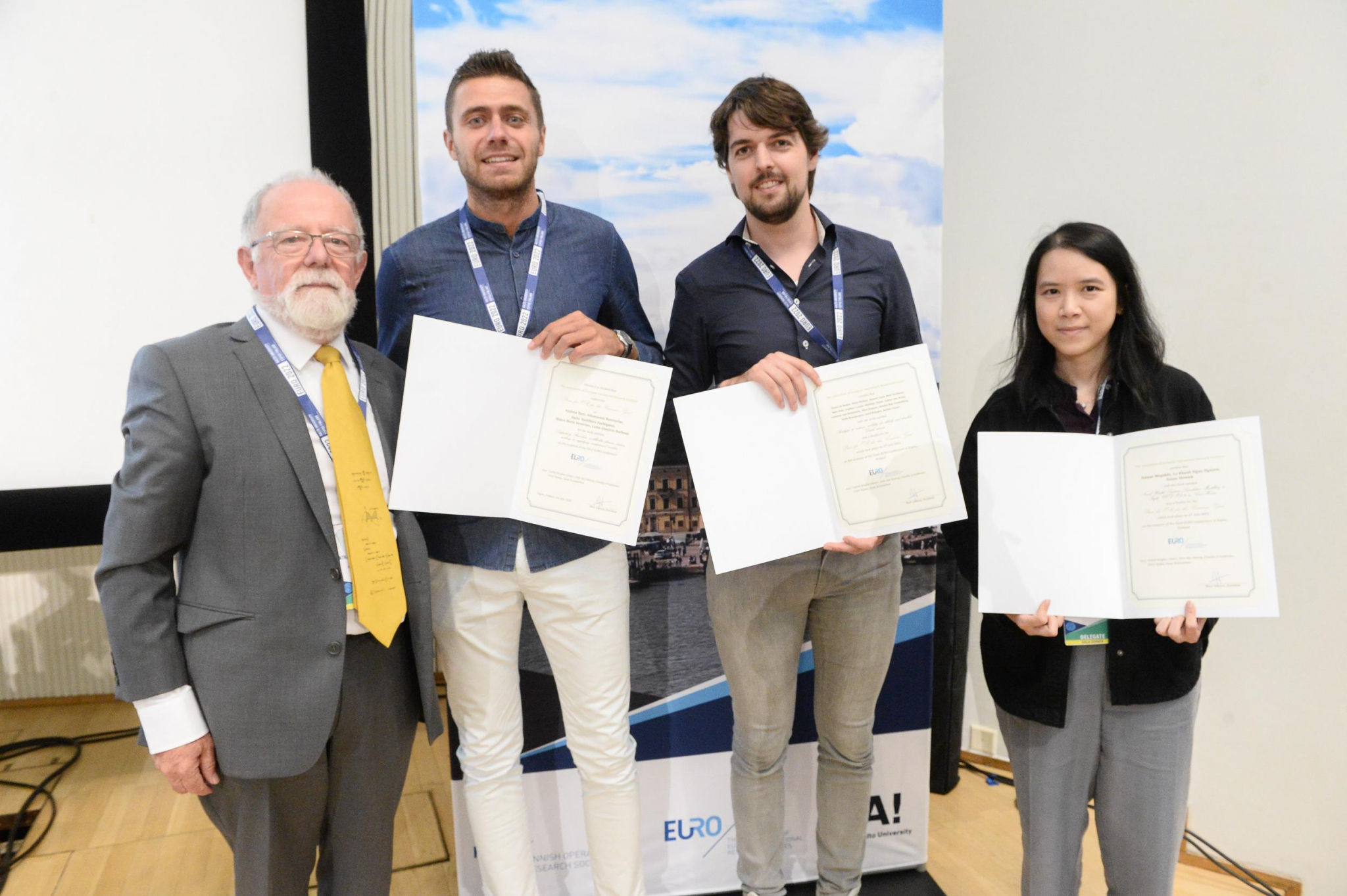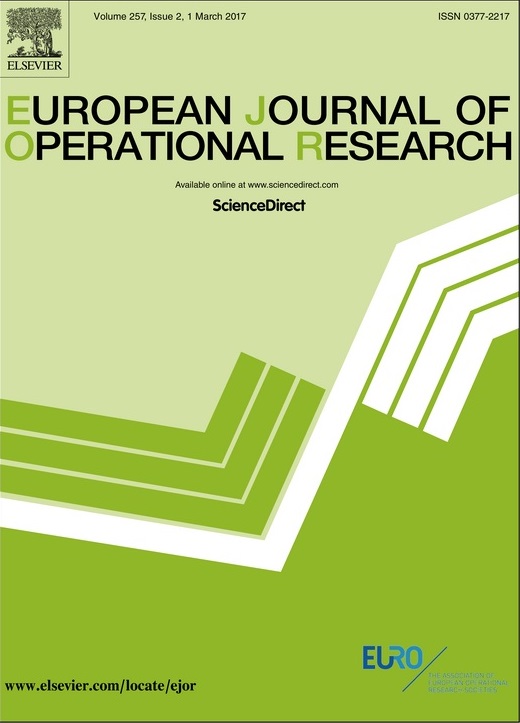EURO Prize for OR for the Common Good 2022 - Finalists
The three finalists of the 2022 EURO Prize for OR for the Common Good are:

CQM: Frans de Ruiter, Peter Hulsen, Jeroen Goes, Bart Verberne, Bart Post, Daphne Looije, Matthijs Tijink, Johan van Rooij
Transvision: Laurens van Remortele, Dion Kaman, Sander Bas Zeelenberg
Geodan: Niels Bourgonjen, Gerd Klingler, Balder Visser
Analytics to improve mobility for elderly and disabled Dutch citizens
In the Netherlands 450,000 elderly and disabled citizens are eligible for subsidized taxi rides executed by Transvision. The day-to-day planning of 3,000 to 15,000 long-distance rides used to be a complex and daunting task split over dozens of subcontractors. CQM and Geodan developed an analytics solution that combines the rides. Starting January 2020, we increased punctuality and reduced ride times, resulting in 50 percent improvement in passenger satisfaction. Furthermore, we saved 75 million driving kilometers or 7,500 metric tons of CO2 emission over the five-year contract term.
Andrea Tuni, Politecnico di Torino, Italy
Athanasios Rentizelas, National Technical University of Athens, Greece
Helio Yochihiro Fuchigami, Federal University of Sao Carlos (UFSCar), Brazil
Maico Roris Severino, Federal University of Goiás, Brazil
Luísa Queiroz Barbosa, Federal University of Goiás, Brazil
Supporting Brazilian smallholder farmers decision making in supplying institutional markets
Smallholder farmers are among the most vulnerable communities in developing countries due to poverty and social exclusion, relying on agriculture for subsistence and employment, while still lacking a stable income due to inconsistent access to markets. Aiming to tackle rural poverty, the Brazilian government established the PNAE program (Programa Nacional de Alimentação Escolar - National School Feeding Program), an institutional market for smallholder farmers to supply their produce to schools through a non-competitive bidding mechanism. Nevertheless, smallholder farmers still face challenges in the evaluation of the profitability of participating in each call of the bidding mechanism. As a result, their participation to PNAE is limited due to the challenging decision-making process.
Aspiring to contribute towards increasing smallholder farmers’ participation, this study aims to support farmers into two key decisions they face during sequential stages of the bidding process, namely whether to bid for each available school and product combination and whether subsequently to accept the awarded bids once the bids’ outcome is known. A decision support system (DSS), based on two sequential mixed integer linear programming (MILP) optimisation models, was developed and applied to the case study of Canudos settlement, guiding farmers on the optimal bidding and contract acceptance strategy.
The DSS models are theoretically relevant for the Operational Research (OR) community from an application and a methodological perspective. This work contributes to the decision support systems field by applying established OR methods, such as MILP, to a real-life problem within the new context of bid/no-bid DSS, being also the first DSS application for non-competitive bidding. Moreover, it is the first work in the bid/no-bid DSS literature, which defines an optimal bidding strategy for the users thanks to the use of optimisation methods. Finally, the work is also original within the bid/no-bid decision-making area by being the first DSS applied to the agricultural and institutional markets contexts, aiming to facilitate decision-making of smallholder farmers in a developing countries context.
The DSS defines efficient school supply regimes for the farmers considering also transportation costs, thus allowing an increased share of the revenue to remain within the smallholder farmers’ communities instead of being wasted in unnecessary transport activities or in supplying non-profitable products. The DSS removes subjectivity and intuition from the decision-making process, leading to faster and more effective bidding strategies. Finally, it removes the obstacle of disagreements within the farmers’ cooperatives on where to bid and which successful bids to select, due to an objective strategy being defined.
The work has a significant social impact for the common good, simultaneously contributing to the UN Sustainable Development Goals, SDG1 “No Poverty”, SDG2 “Zero Hunger” and SDG10 “Reduced Inequalities”. The additional funds available to smallholder farmers thanks to optimised bidding strategies allow to fulfil the intended social outcome of the PNAE program, by offering increased financial security to vulnerable rural communities, helping them to escape poverty. The real-life impact of this work is enhanced since the DSS models have been embedded into a Progressive Web App, accessible from mobile phones. This social technology, coupled with dedicated training sessions to farmers, aims to make the smallholder farmers independent throughout the PNAE bidding mechanism. After being successfully implemented through a single case study in the Brazilian smallholder farmers’ settlement of Canudos, the work could be further applied in additional farmers’ communities in the country, with a potential of 1.5 million users in Brazil, thus being highly relevant for rural poverty reduction efforts in the country. Inclusive rural growth in developing countries is a key objective globally, as it allows to concurrently address food security and economic growth as well as alleviating effects of climate change.
Itamar Megiddo, Strathclyde Business School, UK
Le Khanh Ngan Nguyen, Strathclyde Business School, UK
Susan Howick, Strathclyde Business School, UK
Novel Health Systems Simulation Modelling to Fight COVID-19 in Care Homes
In this talk, we will discuss the contribution of our systems simulation models to care homes’ COVID-19 policy and intervention implementation in the Health & Social Care Partnership Lanarkshire, Scotland (HSCP), and the UK. Care homes, which act as a residence but where most residents are elderly and have complex medical and care needs, have suffered devastating outcomes in the COVID-19 pandemics. They have adopted infection control and prevention interventions and policy from hospitals despite these facilities’ differing roles because research is very limited in the setting.
With this lack of research, we developed novel agent-based models (ABMs) and hybrid models that combine system dynamics and ABM to model care home operations and COVID-19 spread. Staff interviews at HSCP Lanarkshire and care homes and experts gathered through the Scottish Government’s Care Home Data Analysis team aided in developing and validating the models. We also adapted confidence building and validation approaches from the SD and ABM literature to hybrid simulation. We then conducted experiments using the model to explore variation in care home outbreaks and study the effectiveness of policies and interventions in reducing cases and deaths within care homes and across ones connected by agency staff that work across multiple homes. In the talk, we will discuss the models, the evidence our experiments produced, and the policy and intervention decisions they supported.

This work is licensed under a Creative Commons Attribution-ShareAlike 3.0 International License and the GNU Free Documentation License (unversioned, with no invariant sections, front-cover texts, or back-cover texts).



